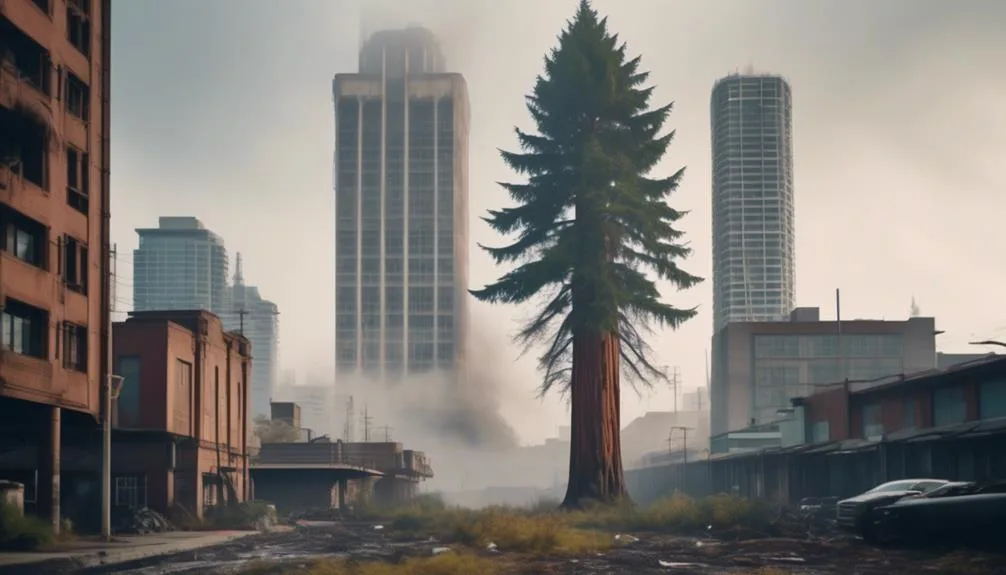The ability of redwood trees to withstand pollution is truly impressive. Their resilience in the face of environmental challenges is remarkable. How do these majestic giants manage to thrive in the midst of pollution, and what impact does this have on their ecosystem?
Discover the secrets behind the redwood tree's ability to withstand pollution and the efforts being made to protect these iconic species in this article.
Pollution Tolerance of Redwood Trees
Redwood trees exhibit remarkable tolerance to pollution, thriving in environments where other species struggle to survive. Their ability to thrive in polluted areas is due to their unique adaptations.
Redwoods can grow in a variety of soil conditions, including those with high levels of pollutants. They've a remarkable capacity to filter contaminants from the soil, allowing them to grow even in areas with poor soil quality.
Additionally, redwood trees have developed a natural resistance to air pollution, making them resilient in urban environments with poor air quality. Their thick bark and waxy leaves act as a protective barrier against harmful pollutants, enabling them to flourish where other tree species might struggle.
This exceptional pollution tolerance makes redwood trees invaluable in combating environmental degradation.
Factors Affecting Redwood Tree Tolerance
Thriving in diverse environmental conditions, the resilience of redwood trees to pollution is influenced by a multitude of factors, including their genetic makeup, physiological adaptations, and symbiotic relationships with soil microorganisms.
The following factors play a crucial role in determining the tolerance of redwood trees to pollution:
- Soil Composition: The type and quality of soil directly impact the tree's ability to absorb nutrients and filter pollutants.
- Genetic Diversity: With a wide range of genetic variations, some redwood trees may possess traits that enable them to better withstand pollution.
- Physiological Adaptations: Redwood trees have evolved unique mechanisms to cope with pollutants, such as specialized root structures and bark features.
- Symbiotic Relationships: The mutually beneficial associations with soil microorganisms enhance the tree's ability to mitigate the effects of pollution.
These factors collectively contribute to the remarkable ability of redwood trees to thrive in the face of environmental challenges.
Adverse Effects of Pollution on Redwoods
Amid the myriad factors influencing redwood tree tolerance to pollution, it's imperative to understand the adverse effects that pollution can exert on these majestic giants. Redwoods are highly sensitive to air quality, and pollution can have a profound environmental impact on their health.
High levels of pollutants, such as ozone and nitrogen dioxide, can damage the foliage, affecting the tree's ability to photosynthesize and ultimately stunting its growth. Additionally, pollutants can weaken the trees' natural defense mechanisms, making them more susceptible to diseases and insect infestations.
Furthermore, air pollution can lead to soil acidification, altering the delicate balance of nutrients and microorganisms that redwoods rely on for sustenance. As a result, it's crucial to mitigate pollution to ensure the continued vitality of these iconic trees and preserve their unique ecosystems.
Redwood Tree Adaptations to Pollution
In the face of increasing pollution, redwood trees have developed remarkable adaptations to safeguard their health and resilience. Despite the challenges posed by poor air quality in urban environments, these majestic trees have evolved to thrive.
Consider the following adaptations:
- Thick Bark: Redwoods have thick, protective bark that acts as a shield against air pollutants, preventing harm to the inner layers of the tree.
- Waxy Coating: Their leaves are coated with a waxy substance that helps repel pollutants, allowing the trees to continue photosynthesizing effectively.
- Deep Roots: Redwoods develop extensive root systems that enable them to access cleaner groundwater, minimizing the impact of air pollution on their overall health.
- Self-Pruning: Redwoods naturally shed lower branches, reducing the surface area exposed to polluted air and enabling the tree to allocate more resources to healthier, upper foliage.
These incredible adaptations showcase the redwood's resilience in the face of urban pollution.
Conservation Efforts for Redwood Trees
To ensure the continued vitality of redwood trees, ongoing conservation efforts are essential to protect and sustain these magnificent giants for future generations to appreciate and enjoy. Redwood forests face significant environmental impact from factors like logging, climate change, and air pollution. Conservation efforts play a crucial role in mitigating these threats and preserving redwood tree populations. Here are some key conservation efforts for redwood trees:
| Conservation Effort | Description |
|---|---|
| Reforestation | Planting new redwood trees to replace those lost to logging |
| Habitat Protection | Preserving natural habitats to maintain biodiversity and ecosystems |
| Air Quality Monitoring | Tracking pollution levels to understand and minimize its impact |
These efforts are vital in safeguarding the majestic redwood trees and the ecosystems they support. Your support and awareness of these conservation initiatives can make a meaningful difference in the continued existence of these awe-inspiring trees.
Conclusion
In the face of pollution, redwood trees demonstrate a level of resilience, albeit with repercussions. While their growth and survival may be impacted, the presence of adaptive mechanisms and conservation initiatives offers hope for their preservation.
The delicate equilibrium between redwoods and pollution underscores the ongoing need for concerted efforts to safeguard these iconic trees in their natural habitat.
Mark Hoffman is a dedicated arborist and tree care specialist with over a decade of experience. His love for trees began when he visited Yosemite National Park as a teenager and was awestruck by the giant sequoias. Mark pursued his passion by studying forestry at Michigan Technological University, where he earned a Bachelor of Science degree.
Since then, he has worked tirelessly in the field of arboriculture, helping to preserve and protect trees in his community. His expertise and dedication have made him a respected leader in the industry and a valuable resource for anyone seeking advice on tree care.
